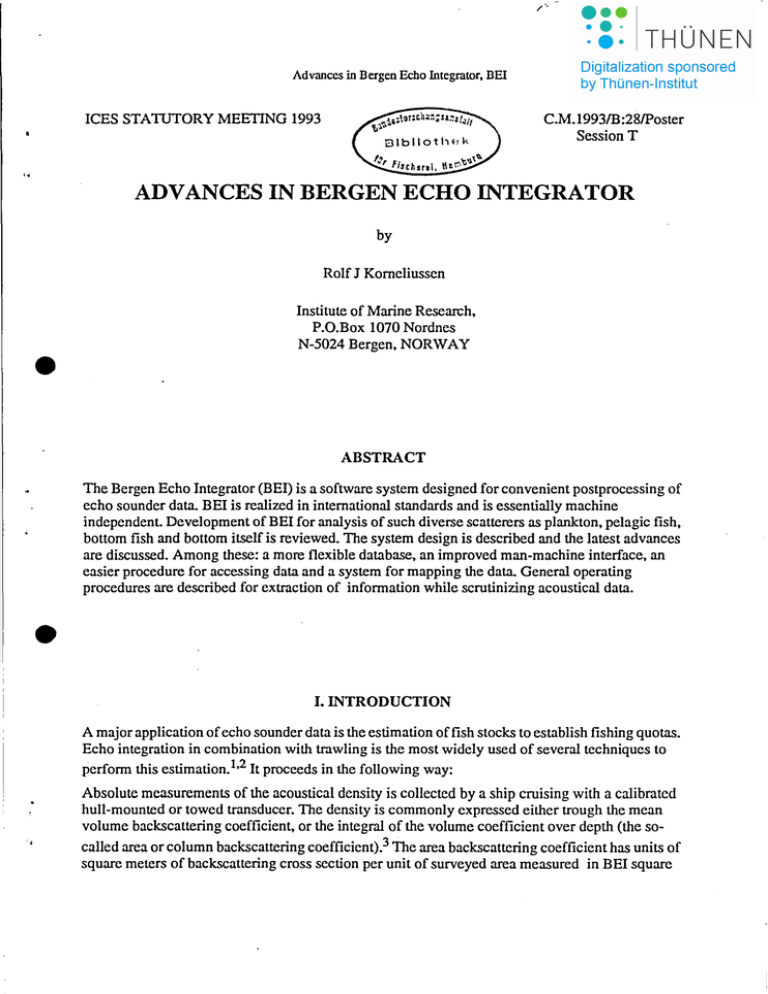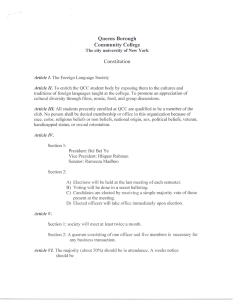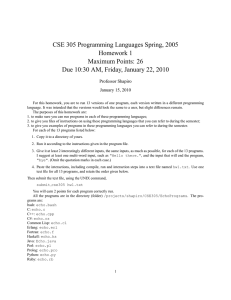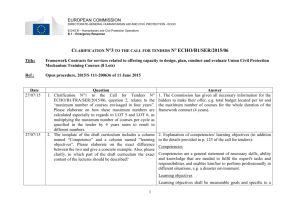. ADVANCES IN BERGEN ECHO INTEGRATOR
advertisement

Advances in Bergen Echo Integrator, BEI ICES STATUTORY MEETING 1993 C.M.19931B:28/Poster Session T . , ADVANCES IN BERGEN ECHO INTEGRATOR by Rolf J Korneliussen • Institute of Marine Research, P.O.Box 1070 Nordnes N-5024 Bergen, NORWAY ABSTRACT The Bergen Echo Integrator (BEI) is a software system designed for convenient postprocessing of echo sounder data. BEI is realized in international standards and is essentially machine independent. Development of BEI for analysis of such diverse scatterers as plankton, pelagic fish, boUom fish and bouom itself is reviewed. The system design is described and the latest advances are discussed. Among these: a more flexible database, an improved man-machine interface, an easier procedure for accessing data and a system for mapping the data. General operating procedures are described for extraction of information while scrutinizing acoustical data. • J. INTRODUCTJON A major application of echo sounder data is the estimation of fish stocks to establish fishing quotas. Echo integration in combination with trawling is the most widely used of several techniques to perform this estimation.1,2 It proceeds in the following way: .. Absolute measurements of the acoustical density is collected by a ship cruising with a calibrated hull-mounted or towed transducer. The density is commonly expressed either trough the mean volume backscattering coefficient, or the integral of the volume coefficient over depth (the socalled area or column backscattering coefficient). 3 The area backscattering coefficient has units of square meters of backscattering cross seetion per unit of surveyed area measured in BEI square Advances in Bergen Echo Integrator, BEI meter per square nautical mHe (m2/nm 2). The number density is determined by dividing the area backscattering coefficient by the mean backscattering cross section of the object fIsh. The Bergen solution to the problem of echo integration owes its origin to the work of G. Vestnes and Dragesund and Olsen,4 as assisted by I. Hoff. The Institute of Marine Research (IMR) based its fIrst digital echo integrator on the Norsk Data ND-I computer.5 The next generation of echo integrators was implemented in a machine language running on a ND-IO computer that went out of production in 1979. In 1987 IMR decided to replace its echo integrator. By the cooperation with experts at Christian Michelsens Research (CMR),a IMR decided to gamble on recent developments in data processing and graphie display teehniques that appeared to be attaining standard-status. The decision was taken to free the echo integrator from hardware. The software standards selected were the UNIX operating system,6 C programming language,7 X \Vindow system,8,9 Structured Query Language • (SQL) for relational databases,10 and Transport Control ProtocollInternet Protocol (TCPflP).11 The Bergen Echo Integrator was documcnted by Foote, Knudsen, Komcliusscn, Nordbp and Rpang in 1991 12 and is reviewed here. 11. SYSTEM DESIGN EffIcient user interpretation of echograms is based on knowledge of experienced scientists. As a consequence, the man-machine interface should reflect both the user requircments and accepted software design principles. • Requirements imposed by users on the system arc the following: (1) ample capacity for processing, displaying and manipulating data from echo sounder preprocessor and other units indicated in Fig.l; (2) machine independence; (3) programming in a high-Ievellanguage; (4) modular construction; (5) database; (6) Ethernet local-area network (LAN); (7) full documentation; and (8) user friendliness. (2), (3) and (4) are fulfilled with the use ofUNIX, C and X. \Vhen the BEI project started ANSI C was not yet defIned and a proper version of X was not available. The Ingres database version of SQL and the SUN version of UNIX were selected. In BEI we have only used functions seeming a part of a future standard. Even ifBEI is converging to the defIned standards, BEI is still not more than 'essentially' machine independent. Advances in Bergen Echo Integrator. BEI lRAWL SAMPLE DATA I '" Pe DATALOGGER ETIIERNET T • Pe DATALOGGER I CID SONDE 1 SATELITE NAVIGATOR LOG / Pe DATALOGGER T 1 GRAPHICS WORKSTATION: T ECIlOSOUNDER PREPROCESSOR BEI & DATABASE I POSTSCRIPT PRINTER Fig. 1. Data network for research vessels. A.DATAFLOW • The data flow was considered as first step in the design. An overview of the data flow is showed in Fig.2. The echo sounder postprocessor is p.t an SIMRAD EK500 capable of operating up to 3 different frequencies simultaneously. Each BEI echo sounder log process logs all data from an echo sounder postprocessor. Using more than one log process it is possible to log data from more than 3 transducers. All acoustical data are stored in high volume files covering 5 nautical miles. The positions are also stored directly in the database. Other types of data are logged by separate log processes. The windows are interacting with the database and the f1les trough the processing module during the scrutinizing process. The interpreted data are stored in the database and may be sent to hardcopy devices like postscript printers using the report generator window. Advances in Bergen Echo Integrator, BEI WINDOWS • I MAP SYSTEM HARDCOPY DEVlCES Fig. 2. Data flow model B.DATABASE At the end of 1990 the current revision of the database model was very flexible with respect to spatial resolution of data. The cost of a slower storing speed compared to earlier datamodels. This became a major concern when Ingres changed its internal architecture from system version 5 to 6. • The storage speed was increased dramatically at high resolutions by writing data to ASCII files and copying into the database. Storing times on a Sun Sparcstation IPX for a typical situation with 2-3 species per channel down to 500 meters: Table 1: Database storage Thickness of bottomreferenced channels (meter) Thickness of surfacereferenced channel (meter) Horizontal resolution (nautical mHes) 2 50 5 2.5 2 50 1 4 2 50 0.1 12 2 10 0.1 30 2 1 0.1 190 Storage time (seconds) Advances in Bergen Echo Integrator, BEI AIi echograrri is a 5 nautical mHe block of echo sounder data identified by codes for nation, ship, survey, frequency, transceiver, date and time. The echogram files are uniquely identified by the content of the database. This elose connection makes the rawdata files an extension of the database. Bottomdepth and the position are stored in the echogram files for each ping. From 1992 positions are stored in the database according to the horizontal resolution (not only one per cchogram as earlier). Restoring of scrutinized echograms into the database can therefore give higher resolutions of positions and its associated date, time and bottomdepth. • In addition to acoustical and oceanographical data (CTD, nutrient, light, ), the database is modelIed to hold data from biological sampling. However, the fish station databaSe tables tumed out to be to static for practical scientific use. This problem reached a solution since IMR in 1991 initiated a project to model all data collected or used by IMR. Tbe BEI database model was handled over to this project with the intention of letting the new model be version 3 of the BEI database. This new model is presented on leES statutory meeting 1993 by R. Komeliussen and others. C. GRAPHICAL USER INTERFACE The graphical user interface consist of the database control window called the Configuration \Vindow, the scrutinize control window named SurveyGrid, the data windows and the presentation windows. Fig. 3. shows the interconnections of the graphical user interfaces and stored data. • ::!::!::il.I·1:":i·I!:.·I:::"i:~i~=~~I~ll!~lt~~;11 ECIl~rW 11\---\-----7'~§~§3 TARGEf SlRENGTII W FILES Fig.3. Interconnections of the graphical user interfaces and stored data. Advances in Bergen Echo Integrator, BEI 1. Log Activity lVindow Thc Log Aetivity \Vindow displays the avmlable disk space and gives a waming if data is riot received or if available disk space is less than a speeified limit. Old scrutinized rawdata files found in the 'waste' directory are deleted if possible to keep the available disk space above the given limit. The euerent fonn ofthe Log Aetivity Window is made after 1991. 2. Configuration lVindow The Configuration Window is uscd to set key data in the database and to set and get informations about eruises. In almost all tables in the database nation, ship, and eruise number are used to associate data. • The thickness of both pelagic or surface-referenced ehannels and bottom-referenced channels are specified through the Configuration \Vindow. The window is also uscd to set default parameters used by other windows. The Report \Vindow will e.g. use default nation, ship and eruise cach time it is exeeuted, but all these parameters may be ehanged in the Report \Vindow. Advances since 1991 The Configuration \Vindow is even easier to use since RCf. 12 was published in 1991. The inherent seeurity is improved. The window ean be started with 3 options: view only, ehange of common parameters allowed and ehange all allowed. 3. Suivey Grid lVindow The Survey arid \Vindow displays the loeation of the eruise data stations. Among these are stations where eehosounder-, trawl-, oceanographie-, and other data are collected. Data from astation selected by the operator will be displayed in the corresponding window if it has been started. Advances • The Survey arid \Vindow turned out not to be very useful both because of great errors in many of the positions received in certairi areas, sometimes as mueh as 30°, and bccause of complieated or overlapping cruise lines. Improving the digital filter removing erroneous positions dtiring the logging proeess and adding a new filter replaeing erroneous positions read from the database with interpolated positions have reduced the position error problem. The possibility of limiting the displayed cruise lines both in time and aerial dimension have made the Survey arid \Vindow a useful tool during the scrutinizing process. 4. Echogram lVindow The Eehogram \Vindow is viewed in Fig. 4. The Echogram \Vindow consist of four different subwindows; those of the main echogram, expanded bottom, color map and zoom. The first two subwindows are displaycd with markers spccifying depth range, vcssellog, and layer limits. New layers ean be inscrted, moved, deleted, or redrawn at will. Advances in Bergen Echo Integrator, DEI The Expanded Bottom Window displays a specified bottoin area, usually 5 meters below and 10 meters above the bottom detected by the echoprocessor. The detected bottom is marked by a line that can be corrected duririg the scrutinizing process arid ends up with the bottom used by BEI. Different colormaps are available. The commonly used colormap markS strong backScattCring with a dark warm color (dark red) and weak scatterers with light cold colors (light blue) in accordance with accepted Scicntific principles for color usage. The Color Window is also used to set noise level; the weakest echo used in the calculations. Echoes below the noise level rire marked with white. . Ad...ances The only visible change in the Echogram \Vindow is the redirection of the error messages from standard output to windows. This improvement is provided by H. Nes at Simrad Subsea. • 38 kHz echogram. Scrutinized as mainly herring in school. Cod below curved layer limitation. Sv dB) ~. Bottom Accumulated SA in bottom channel Fig. 4. The Echogram-, Interpretation and Target Strength \Vindows. Advances in Bergen Echo Integrator, BEI S. Interpretation lVindow The Interpretation Window shown in Fig. 4 is used by the scientist during the scrutinizing process as a notebook for his observations. The basic data are extracted from either of two kinds ofregions; either a rectangular box of operator-set-and controlled limits or a horizontal layer indicated by the operator using the same. The scrutinized data are stored in the database with the horizontal resolution indicated on the pressed Store-Button. Adllances Different resolutions give very different storage time. H. Nes at Simrad Subsea has provided function to display the database storing activity. • Scientists often wants to add a comment to the scrutinized data. Comments are connected to the data trough the Comment Sub-Window popping up when the comment-button is presscd. Commonly used comments are: 'Trawling', 'Bad weather', 'Uncertain scrutinizing' . 6. Target Strength lVindow Target strengths corresponding to resolved single-fish echoes are collected in a histogram that is displayed in this window. The basic data are the same as for the Interpretation Window. Adllances It is possible to store the basic data to ASCII files. This has turned out to be a useful function for special target strength research projects. 7. File Selection lVindow This window provides an alternative means of selecting acoustical data, e.g. when navigation data are lacking. Adllances • Amount scrutinized data stored in the database is viewed. 8. Punch lVindow This is a new window that will be available on all institute ships from 1994. Acoustical raw data are sometimes not available from BEI. The problem may be caused by the network. the echoprocessor or the workstation. This has not been a big problem. Data from the echoprocessor printouts are sometimes used in addition to the database data to estimate the fish stock size. Reestimation using new methods on the database data some years later is then not direct1y comparable with the original estimations. The Punch Window together with the EchogramlInterpretationrrS windows complete the scrutinizing system. Advances in Bergen Echo Integrator, BEI 9. Fish Station Window The Fish Station Window is used to display trawl catches or other fishing operations. The window is almost never used. (See the database discussion). 10. STD lVindow This window displays the dependencies of salinity and temperature of depth, as measured by an eID-sonde. Advances The window is redesigned to be able to show parameters derived by the CTD data, e.g. speed of sound. Other types of data, e.g. nutrients, can also be displayed. • 11. Report lVindow The Report Window is the man-machine interface used to generate reports and was not implemented in 1991. The design for retrieving of data is optimized to be fast. Tests have shown that a bad design can be hundreds of times slower than a good one. The Report Window and the data flow are illustrated in Fig. 5. At (4) -> (5), all retrieved data are delivered to the users in arrays of records. The user selects a subset of these data to be printed out For simple reports, a single print statement is all that is needed. At this stage 9 different report types may be generated in one operation pressing the Scatter-Button. Each type ofreport can be printed in 0.1 - 5 nautical miles resolution simultaneously ifthe data are stored with 0.1 nm horizontal resolution in the database. (1) Set parameters for selecting the data (2) Select sorted data from DB into virtual tables in one operation • (3) Retrieve dat in a feteh loop record by record (4) Aeeu1ulate da!into arrays of reeords. \Vhen all data from a staUon are read: ( ) (5) Print data to files. Return to main program when finished. Fig. 5. The Report \Vindow and the data flow [rom the DB to files. Advances in Bergen Echo Integrator, BEI III. SCRUTINIZING PROCEDURES A commonly used scrutinizing procedure is as follows: • • Start the needed windows, e.g. Scrutinize, SurveyGrid and STD. Select data. • Set hottom expanded window inactive in case ofbad bottom detection. • Set noise level and color scale. • Use Interpretation Window to set factors for bubble and bottom correction. Stored in database: SAKbubble for surface referenced channels and SAKbubbleKbottom for bouom referenced channels. • Correct detected bottom line. • Draw layer lines. • Use school boxes if necessary. • AIlocate SAintegral to species in upper layer. Consider: time, depth, color I noise level, target strength, zoom, trawl catches, salinity-temperature-depth measurements • Move on to next layer and repeat. • Store scrutinized data. • Get next echogram using SurveyGrid or FiIeSelection Window. IV. THE l"fAP SYSTEM BEI&lap • The Map System is developed in cooperation with IMR, CMR and Simrad Subsea. User requirements and essential parts of the man-machine interface are specified by IMR. The program design and the programming is made by Per Erik Nordbp at CMR. Simrad Subsea will start industrializing the system during 1993. First step using BEI/Map is to manually correct cruise lines or to remove lines not significant for presentation. Corrected cruise lines and its associated data can either be exported to files readable from commercial graphical systems or be presented in 3 different maps, alt with coastlines available: • Cruise lines with symbols for data stations. • A veraged SA within a specified aerial grid. • SA isoline contour map High resolution coastlines from all of the world is provided as a part of the system. Advances in Bergen Echo Integrator, BEI ACKNOWLEDGEMENTS I wish to thank K. Foote for his continuing support. Invaluable advice has been received from colleagues at IMR throughout the development. A. Raknes and I. R~ttingen have participated in the group advising the Map sub-project. P. Nordb~12 at CMRa have done essentially all software design and programming on the BEI/Map system so far. Likewise I would like to thank H. Nes at Simrad Subsea for his contributions. H. Nes is responsible for the industrialized version of BEI called BI500. Additional financial support is provided by the Norwegian Council for Fisheries Research. • Advances in Bergen Echo Integrator, BEI REFERENCES a Christian Michelsen Research, Fantoftvegen 38, N-5036 Fantoft, Bergen, Norway. i 1 S. T. Forbes and O. Nakken (Eds.), "Manual of methods for fisheries resource survey and appraisal. Part 2. The use of acoustic instruments for fish detection and abundance estimation," FAO Man. Fish. Sci. 5, 1-138 (1972). 2 D. N. MacLennan, "Acoustical measurement of fish abundance," J. Acousl. Soc. Am. 87, 1-15, (1990). 3 O. Dragesund and S. Olsen, "On the possibility of estimating year-class strength by measuring echo-abundance ofO-group fish," Fiskeridir. Skr. Sero Havunders. 13(8),48-75 (1965). 4 C. S. Clay and H.Medwin, "Acoustical Oceanography: Principles and Applications," (\Viley, New York, 1977). ~ 5 J. Blindheim, P. K. Eide, H. P. Knudsen, and G. Vestnes, "A ship-bome data logging and processing system for acoustic fish surveys, Fish. Res. 1, 141-153 (1981/1982). 6 M. G. Sobell, A Practical Guide to UNIX System V (BenjaminlCummings, Menlo Park, Califomia, 1985). 7 B. W. Kemigham and D. M. Ritehie, The C Programming Language (Prentice-Hall, Englewood CHffs, NJ, 1978,1988). • « ". 8 R. W. Scheifler, J. Gettys, and R. Newman, X \Vindow System (Digital, Bedford, MA, 1988). 9 D. A. Young, X Window Systems: Programming and Applications with Xl. OSF/M:OTIF edition (Prentice-Hall, Englewood Cliffs, NJ, 1990). 10 C. • J. Date, A Guide to the SQL Standard (Addison-Wesley, Reading, MA, 1987). 11 D. E. Corner, Intemetworking with TCP/IP: Principles, Protocols, and Architecture (Prentice- Hall Intemational, London 1988). 12 Kenneth G. Foote, Hans Petter Knudsen, and Ralf J. Komeliussen. Per Erik Nordb~ and Kjell R~ang, "Postprocessing system for echo sounder data", J. Acousl. Soc. Am., Vol. 90, No. 1,3747, July 1991. 13 S. Floen, H. Gj"sreter, R. Komeliussen, H. Sagen, P. Thorvaldsen and V. \Ven"nevik, "An integrated database for marine research", Ta be published on ICES STATUTORY MEETING 1993JSession T.





